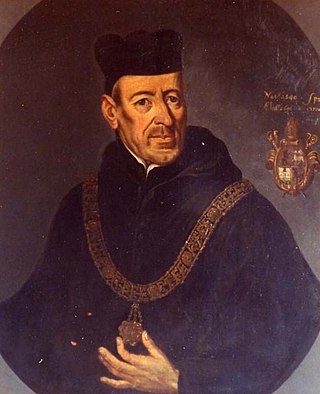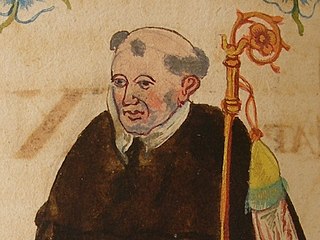Related Research Articles

The Abbey of Saint Gall is a dissolved abbey (747–1805) in a Catholic religious complex in the city of St. Gallen in Switzerland. The Carolingian-era monastery existed from 719, founded by Saint Othmar on the spot where Saint Gall had erected his hermitage. It became an independent principality between 9th and 13th centuries, and was for many centuries one of the chief Benedictine abbeys in Europe. The library of the Abbey is one of the oldest monastic libraries in the world.
Notker Physicus was a monk at the Abbey of Saint Gall, active as a physician, painter, composer and poet. He is best known for his medical prowess, and may have been physician to the Holy Roman Emperors Otto I and Otto II. His paintings, now lost, were well regarded in his time, and two of his compositions survive, a office and hymn.
Ulrich of Eppenstein served between 1071 and his death as Abbot of the powerful Abbey of Saint Gall. Ulrich was prominent as a supporter of Emperor Henry IV during the civil wars that erupted out of the power struggles between the emperor and the papacy during the closing decades of the eleventh century.
Konrad von Gundelfingen was prince-abbot of the Princely Abbey of Kempten from 1284 until 1302. He was also anti-abbot of the Princely Abbey of Saint Gall from 1288 until 1291, appointed by King Rudolf I.
Notker was the abbot of the Abbey of Saint Gall from 971 to 975. Notker was recommended for the office of abbot by his predecessor Purchart I. His election occurred on 18 May 971. He was the nephew of Abbot Thieto and Abbot Craloh as well as of Notker the Physician.
Thieto was abbot of the Benedictine Abbey of Saint Gall from 933 to 942.
Anno of Saint Gall was anti-abbot to Craloh in the Benedictine Abbey of Saint Gall.
Purchart I was the abbot of the Benedictine abbey of Saint Gall from 958 until 971.
Purchart was abbot of the Abbey of Saint Gall from 1001 to 1022.
Nortpert was abbot of the Abbey of Saint Gall from 1034 to 1072.
Lutold was counter-abbot of the Abbey of Saint Gall from 1077 to about 1083. Nothing is known about his life before and after his work in Saint Gall. In the oldest lists of abbots, Lutold is missing.
Heinrich von Twiel was counter-abbot of the Abbey of Saint Gall from 1121 to 1122.
Manegold von Mammern was abbot of the Abbey of Saint Gall from 1121 to 1133. He descended from a noble family from the area around Untersee. He is documented for the years 1125 and 1126.
Eglolf Blarer was abbot of the Abbey of Saint Gall from 1426 to 1442.

Leodegar Bürgisser was abbot of the Abbey of Saint Gall from 1696 to 1717.
Joachim Opser was abbot of the Abbey of Saint Gall from 1577 until 1594.
Heinrich von Ramstein was abbot of the Benedictine Abbey of Saint Gall from 1301 until 1318.

Wilhelm I Count of Montfort was prince-abbot of Saint Gall from 1281 until 1301.
Heinrich von Wartenberg was anti-abbot of the Abbey of Saint Gall from 1272 until 1274.
Engilbert II was a Benedictine monk and scribe of the abbey of Saint Gall. He served as abbot between 925 and 933.
References
- 1 2 3 Vogler, Werner (1986). "Kurzbiographien der Äbte". In Duft, Johannes; Gössi, Anton; Vogler, Werner (eds.). Die Abtei St. Gallen. St. Gallen. p. 114. ISBN 3-906616-15-0.
{{cite book}}: CS1 maint: location missing publisher (link) - ↑ Henggeler, P. Rudolf (1929). Professbuch der fürstl. Benediktinerabtei der heiligen Gallus und Otmar zu St. Gallen. Zug. pp. 88–89.
{{cite book}}: CS1 maint: location missing publisher (link)